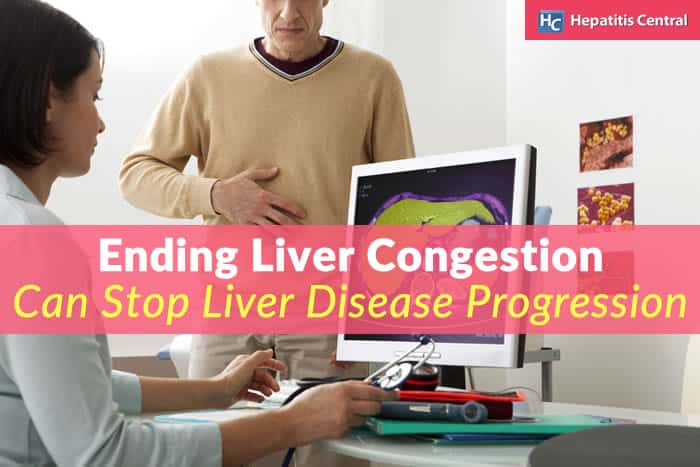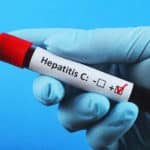Ending Liver Congestion Can Stop Liver Disease Progression


Some healthcare clinicians refer to “liver congestion” as accepted nomenclature for liver health impairment. Others consider congestion as a problem limited to mucous obstruction of the sinuses and lungs. By acknowledging the concept of liver congestion as an impediment of blood and bile flow throughout the liver, the limitation relating congestion only to mucous is lifted. With this broadened understanding, liver congestion perpetuates the damage incurred by the Hepatitis C virus – and recognition of this sequence can aid in its prevention.
About Hepatitis C
Earning the distinction as the most common blood-borne infection in the United States, the Hepatitis C virus primarily infects liver cells. Some facts about Hepatitis C include:
- At least three quarters of those infected develop chronic Hepatitis C infection.
- Causing inflammation and damaging liver cells, chronic Hepatitis C can progress to severe liver disease if unabated.
- Hepatitis C usually progresses slowly – typically taking 10 to 40 years before symptoms or complications from the virus emerge.
- As the Hepatitis C virus damages more liver cells, blood flow throughout this vital organ is restricted.
- Any additional factors that congest blood or bile flow within the liver worsen the potential damage the Hepatitis C virus can cause.
- Chronic Hepatitis C infection is associated with an increased chance of developing hepatocellular carcinoma, a type of liver cancer.
Hepatitis C Disease Progression
Given enough time to fester, Hepatitis C can cause damage to the liver, progressing in the following way:
- Fibrosis – Scarring of the liver that may be reversible.
- Cirrhosis – Severe scarring of the liver that is described as a permanent hardening of liver tissue.
- Decompensated Cirrhosis – Extensive scarring of the liver that prevents its ability to function properly. This is potentially life threatening and typically requires a liver transplant.
Another way to perceive the progression of Hepatitis C is, the more congested the liver becomes, the greater the degree of liver damage. On the other hand, improving circulation of blood and bile throughout the liver brings liver cells the nutrients needed to repair and thrive while flushing out substances that are harmful and congesting.
Liver Congestion Contributors
In addition to the damage that Hepatitis C viral particles inflict, there are additional key contributors to liver congestion. Toxin and fat accumulation are two of the most likely aggravators of liver congestion.
- Toxin Accumulation – One of the liver’s roles is to detoxify the blood. However, substantial toxin exposure damages liver cells, which reduces the liver’s ability to detoxify. Working to reduce the amount of toxins the liver must process helps ease liver congestion.
Top liver detox strategies include:
• abstaining from alcohol consumption
• getting regular exercise
• avoiding foods laden with chemicals
• increasing water intake
• minimizing exposure to environmental toxins
• supplementing with herbs that help detoxify liver cells, such as those contained in Clinical LiverSupport
- Fat Accumulation – Excess fat in the liver (steatosis) is seen in more than half of all people with Hepatitis C – two to three times more than the general population. Studies have found that the combination of Hepatitis C and steatosis increases the risk of liver disease progression and may contribute to the development of liver cancer.
Liver congesting steatosis can be reduced or reversed by:
• losing excess weight
• avoiding alcohol consumption
• getting regular exercise
• eating a healthy diet
• minimizing sugar and simple carbohydrate consumption
• supplementing with herbs that help mobilize bile and metabolize liver fat, such as those found in Clinical LiverSupportLiver congestion is not defined by mucous accumulation, but rather by impaired circulation. Those with Hepatitis C can help prevent liver disease progression by reducing congestion in their liver. By taking various steps to minimize toxin and fat accumulation, circulation in the liver improves. As congestion in the liver lessens, each cell is better nourished. Improved liver cell nutrition leads to better health and liver function – dampening any detrimental effects of the Hepatitis C virus.
http://hcvadvocate.org/hepatitis/factsheets_pdf/FAQ_eng.pdf, Frequently Asked ?’s About Hepatitis C, Retrieved September 11, 2016, Hepatitis C Support Project, 2016.
http://hcvadvocate.org/publications/fact-sheets/hcsp-fact-series/hcv-disease-progression-facts/, HDV Disease Progression, Retrieved September 11, 2016, Hepatitis C Support Project, 2016.
http://mysickliver.weebly.com/compensated-vs-decompensated.html, What is “Compensated vs. Decompensated” Cirrhosis?, Retrieved September 11, 2016, My Sick Liver, 2016.
http://www.christopherhobbs.com/library/featured-articles/hepatitis-c/, Hepatitis C, Retrieved September 11, 2016, Christopher Hobbs, 2016.
http://www.liversupport.com/3-safe-ways-to-detox-your-liver/, 3 Safe Ways to Detox Your Liver, Nicole Cutler, L.Ac., Retrieved September 11, 2016, Natural Wellness, 2016.








17 Comments
Rpbert is on kidney dialysis, he took the meds that cleared up his hepc, Now he is wearing this med patch all the time to help with his pain he has, I guess from being on dialysis for so many year, What I am wondering is could patches intefer with his live and cause the HepC to come back, If any one could give me an answer to this I would be most grateful
Pain medication, cause hep c to come back? My answer would be, No.
HepC is a virus. So if he has gotten rid of the virus and cleared it then the only way to get the virus back is to be reinfected with another strain of the virus. Using pain medication is not relevant unless he was using some illegal intravenous drug which is how most people acquire it in the first place. My answer is no.
no he doesn’t use anything illegal, thanks for your answer of no, thats a relief for me to hear
Hep C won’t come back from pain patches, but his doctor needs to prescribe drugs that are processed in the kidneys rather than the liver whenever possible. Everything we take goes through one or the other.
I lived with hepC for about 42 years…I was cured in October with Harvoni and I am so grateful. I have been told by doctors that I have no scaring or signs of liver damage. I totally attribute this to my lifestyle. I went undiagnosed for 20 years and during that time drank moderately but when I was diagnosed I drank very occasionally. I did acupuncture on a regular basis, drank green drink everyday, ate mostly organic and took liver supporting vitamins. Although I was very scared when I was first diagnosed I saw Hep C as a teacher not as an enemy. I made friends with my Hep C. It kept me living mindfully and for that I was grateful. It was emotional to say goodbye to a disease I had become friends with but I have kept the lesson of living with a life threatening disease. Eating well and taking care of my body are among the lessons that serve me well.
wacko.
I strongly disagree with cadillacrich. Hep C may have been the best thing that ever happened to me. It completely changed my self-destructive habits (alcohol and drugs), gave me the awareness that I controlled by own destiny by eating better, exercising more and by placing my faith (that is a choice) in a Gracious God that gave me hope no matter what happened in my battle with Hep C. I am now “cured” after treatment with Epclusa. Even though I have cirrhosis of my liver, I feel healthy, happy and ready to encourage others that having Hep C is not the death sentence that I thought it was when first diagnosed 26 years ago. e’Layne, your story should be an inspiration to us all. Thank you!
https://uploads.disquscdn.com/images/966633f552671c358c5862bf380dc8bb5c232a7747bde7d4d6e5b04893db6334.jpg I had my yearly ultrasound for my Hep C, I have had it 31 yrs, did one treatment didn’t work.
I go April 6 for ultrasound , next day doc calls and said they have found a couple of things so she booked me the next week for ct with the contrast drink and dye. I went yesterday and got my results and please I cannot find very much info on this , my doc is even confused over it. The report said I have swollen lymph nodes and the largest , 9 mm (they call them periportal and peripancreas, the big one sits lateral to the head of the pancreas which intermittent .
Now a MRI is next. I am worried about this, because no .one seems to know anything , why, what .
Any help would be much appreciated. Thanks corey
I can’t believe this is suppose to be a site to tell your story and I finally do and not one person replies to. It well thanks. Sure made my day. I will no longer use this site at all if this is the support you get seems like it is a site of people who know each orther and that is what is important , thank she for caring what a joke
Corey, I’m sorry you didn’t receive a response, but please know that we state at the beginning of the comments section that the comments are for people that visit the site to discuss topics posted. The Editors will not respond to questions posed in article comments publicly.
As we don’t know your specific situation, we can’t assume to know why your lymph nodes are swollen at this time. This is why your doctor’s are moving forward with additional testing to get more information. The physicians that are familiar with your health and history are best able to answer questions regarding your health than any online forum. With the additional information you’ll gain, if your doctor is still confused our recommendation would be to get a second opinion.
Don’t join the discussion cause they are all one sided
Hi Corey,
Don’t give up hope. There are many of us who care and share your pain. The best advise I can give you is simple. Look to God for all of your strength. He will never give you more than you can handle. Spend time researching on the internet. There is a wealth of information out there, more than any one person, including your care giver could ever process. Make sure you eat a healthy diet and exercise, exercise, exercise. I believe exercise is the single most important thing you can do (besides prayer) that can change your outlook and the way you feel. God bless you, Corey. I will be praying for a full recovery.
I don’t understand I had hep c found out in 1994 had Salvadoran and olysio treatment 2013 I am hep c free BUT developed chirosis didn’t find this out until testing done just before the treatment. I still after many good doctors don’t know how bad my liver is but dec of 2016 was not at stage to be put on liver transplant list. No more hep c but I never felt better barely ever have enough energy to do a damn thing. I’m now 65 and have so many problems. What can be done to boost my energy and feel less exhausted doing nothing. HELP
Angela, I also have cirrhosis from 45 years of being infected with Hep C. My doctor feels it is “Non-compensated” and says that I can live a full and long life as long as I avoid alcohol, drugs that are processed in the liver (Tylenol is one of the worst), avoiding exposure to chemicals, keeping my weight down and exercising daily. I will be 65 in October. Try starting out slow with the exercise, keep a daily journal and make sure you stick with it. Diet has a huge impact on how we feel. Stay away from processed food, sugar and especially diet soda, regular soda and “power drinks”. It as fresh and “raw” as you can. Also get plenty of fresh air and turn off your TV! Listen to good music, read inspiring books and place your hope in God at all times. Spend time in prayer and meditation and make sure you have plenty of contact with family and friends. Do you have a pet? Get one and love it with all your heart. Most of all, try encouraging others, teach some kids how to read or garden and live everyday like it was your last. I have faith that you will find health and happiness by placing one foot in front of the other and keep going forward. May God bless you!
Thank you for the advice , I also suffer with bi polar, add and hear voices, I am on meds for all that but it makes this disease worse. This virus I find also ,after this many years of having it, 31 yrs, seems to really play with your head and emotions. I seem to be more afraid then ever, I have no friends but I choose that , and family they are spread out everywhere as far as England so I am kind of on my own with this right now.
I have noticed a few of you rely heavily on God and prayer, I am not much of a believer, I know there is something but don’t know yet what ,to me its hard to believe in something I have never seen and the way the world is , little kids getting hurt, specially girls and women, I don’t think if there really was a higher power, like God then there would not be all this abuse, sexual, physical,and mental, no god would let kids suffter like that , why? He can perform miracles and who makes the choice who gets abused when they are born , to me that is a mean man to let that happen to any of his apprent children, I have a problem with that , I have a higher power but it is not god, it is of my choice, as long as it does the same ,keeps you on the straight and narrow. I will always protect children and animals. they are so innocent. Thank you every one and please let me believe what I believe
Corey, I will always respect your personal choices. Belief is something that each of us have to come to terms with individually. God will not force himself on anyone.
I am an addict. I struggled with alcohol and drug abuse for years. When I first found out I had Hep C 26 years ago, I stopped drinking and drugging for a little while. It was a struggle that I could not handle. I went back to the drinking, mostly because that was my drug of choice. I knew better but the alcohol won, time after time. I was miserable sober and I was miserable drunk, except when I passed out. I was losing my family, my health and had already lost my self-respect. Out of complete desperation, I turned to God because I was at the end of my rope. I was a broken human being. I turned to God and He did not turn me away. It is a pretty simple story. God has not taken away all my problems but He did miraculously take away my desire to drink. I cannot explain it but God was so merciful when it came to my battle with the bottle. I guess He realized that I could not win the battle on my own and I am living proof that God still performs miracles.
Being sober is the greatest gift that I have ever received. It changed my attitude and that’s when I decided to go for the treatment (Epclusa). It changed my marriage, my fatherhood and how I get up in the morning. I no longer have a hang-over, filled with self-hatred, depression and anger towards the world. I still struggle with daily issues in my life but now I have someone to turn to. It is a 180° turn in my life and even if I was to die tomorrow, from the effects of 40+ years of Hep C and alcoholism and drug abuse, then I will die a happy and changed man.
I hope and pray for the best for you. If I could take away your pain, I would. I am so convinced that your life could change for you just like it did for me that I am willing to challenge you to give God a chance. What have you got to loose? I will never bug you again about this and will respect your space, that I promise. The choice is 100% your own. Give Him your problems, your depression and He will not let you down.
God bless you, Corey,
John